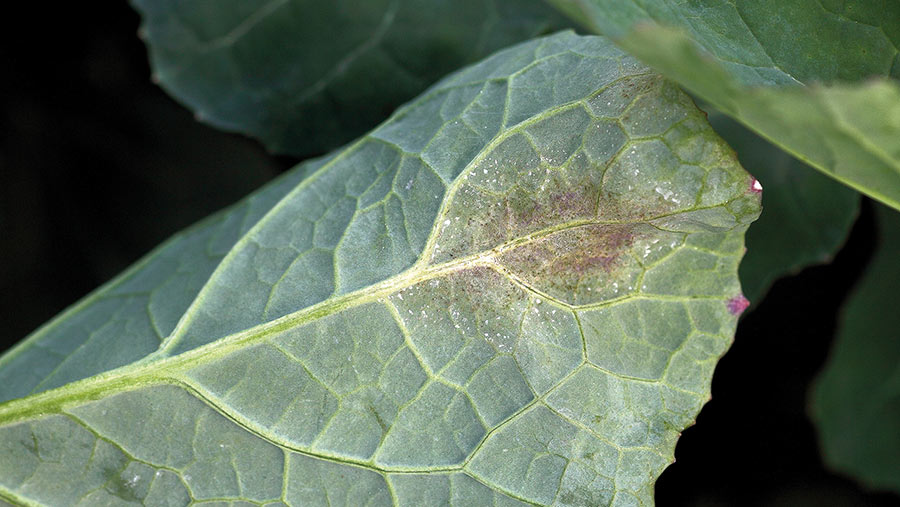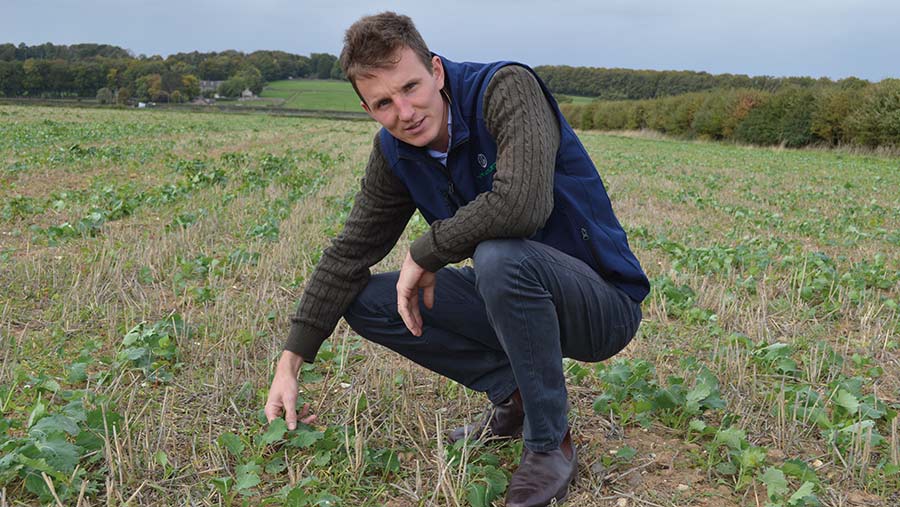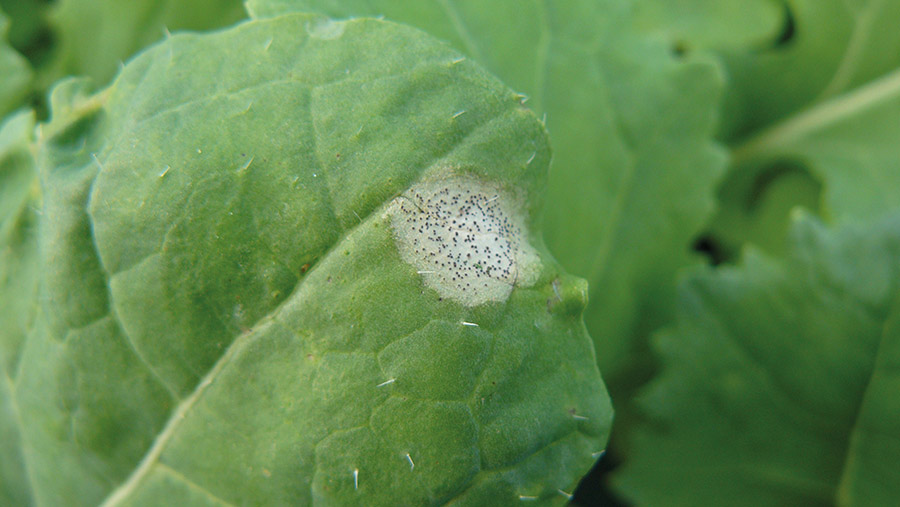Oilseed rape grower uses free disease test for light leaf spot
 © Blackthorn Arable
© Blackthorn Arable Britain’s largest farming group Velcourt is using free disease testing on its oilseed rape crops to finely tune fungicide treatments to protect against the yield-damaging and hard-to-identify disease light leaf spot.
The company grows more than 5,000ha of rapeseed from the Moray coast in northern Scotland down to Dorset.
It is using a SpotCheck service funded by agrochemicals and seeds giant Bayer to detect the disease before it is visible to the naked eye when walking across a field.
See also: Oilseed rape grower cuts back 20% on expensive nitrogen
Good disease control is likely to be even more important this season with vulnerable often late-drilled small plants going into the autumn and winter, and potentially good crop returns due to high rapeseed prices.
The testing could also be a key element in integrated pest management (IPM), or using treatments only when there is a clear risk.
Velcourt’s head of crop production technology, Nick Anderson, says the group has been using the free disease testing service for three seasons.
He sees it as key to timing treatment accurately, which can also help with countering disease resistance to fungicides.
“We see variable levels of light leaf spot even across varieties on an individual farm, so we see this test as a key part of IPM for us,” he tells Farmers Weekly.
Key break crop
The group, which farms 56,000ha across Britain, sees oilseed rape as a key part of its rotations, being its most profitable combinable break crop, and yields last year across its farmed area were 3.5-4.5t/ha.
The disease test service is operated by crop consultant Adas on behalf of Bayer and is in its sixth year of operating, attracting about 400 growers and agronomists annually.
The service operates from 1 October to the end of March, and as well as detecting light leaf spot it can test for phoma and downy mildew.
Light leaf spot is often difficult to spot in the early stages of infection and can be bubbling up under a leaf’s surface before the disease is visible.
It eventually appears as small white dots which can look like tiny grains of sugar and may be seen scattered across the top or underside of leaves where the fungus is erupting from the leaf surface.
Fungicide treatments provide mainly protectant activity against the disease, so the testing service can help growers to identify early signs of infection and when to spray.
Yield benefits
Autumn disease control in oilseed rape is often focused on both light leaf spot and phoma, and the average yield response for controlling the two diseases with fungicides is 0.3t/ha for phoma, and a larger 0.6t/ha for light leaf spot, according to AHDB data.
Both diseases are encouraged by rainfall, and although Velcourt is seeing no signs of phoma at present, many parts of the country are now close to spray thresholds and are likely to see the disease appear in the coming weeks (see “Phoma alert”, below).
In view of the generally small plants this season, the group will use a spray threshold of 10% plants infected, as disease can quickly spread from the leaf to the stem in small plants to form damaging stem cankers.
It is still too early to see any signs of light leaf spot.

Olly Pemberton © MAG/David Jones
Olly Pemberton, a Velcourt agronomist covering Oxfordshire and north Wiltshire, says he will start collecting samples of about 30 leaves for testing from the end of October.
He will test crops again after the winter, especially vulnerable crops with low disease resistance ratings. Samples are sent to Adas for diagnosis.
The Adas test incubates the leaves for signs of infection and can give a result via email within five days.
This is seen as a more accurate method than some growers use by taking a few leaves in a plastic bag and putting them in a warm place such as an airing cupboard to watch for symptoms developing.
To send in leaf samples for light leaf spot assessment and diagnosis, request a sample pack from Adas Boxworth by calling 01954 268 200.
Disease resistance
There is a limited varietal range for light leaf spot resistance with the majority of varieties on the AHDB Recommended List being scored 6 or 7.
One, Aviron, scores 8, and three either clubroot resistant or Clearfield varieties score 5s, in a 1-9 scale with a high figure showing good resistance.
Phoma resistance shows a wider range, with Tennyson and Crossfit showing 9s, and some as low as 4s.
Some of the older specialist High Erucic Acid Rape (Hear) varieties which are still widely grown are noted for weakness against both diseases.
Disease control in the autumn is largely based around azoles.
Difenoconazole is effective against phoma, prothioconazole controls both phoma and light leaf spot, and tebuconazole has light leaf spot activity and some plant growth regulator (PGR) properties.
In addition, another azole metconazole has moderate activity against both diseases and PGR activity.
This season, the fungicide treatment strategy for Velcourt, if disease is detected, will be based on prothioconazole.
This will control both diseases and could be tank mixed with post emergence herbicides such as arylex+picloram (Belkar) or propyzamide (Kerb).
Resistance management
Work at Rothamsted Research has shown some signs of insensitivity to azoles in controlling light leaf spot in the laboratory.
And although a loss of efficacy has not been seen in the field, this has prompted the use of alternative mode of action fungicides to azoles to prevent disease resistance to azoles building up.
Therefore, Velcourt is planning to use the SDHI bixafen-azole prothioconazole product Aviator in early spring if further disease control is needed, and adding in tebuconazole if any PGR activity is required.
Ella Bull, commercial technical manager for Bayer, which markets Aviator, says the SDHI-azole product is available at a small price premium to its own prothioconazole (Proline) to reflect its better efficacy.
Alternative fungicides with no azole at all include Pyrafen and Shepherd.
Both contain the older SDHI boscalid and the strobilurin pyraclostrobin, says fellow agrochemical firm BASF which markets the two products.
There is an alternative DNA light leaf spot test called SwiftDetect, developed by biotechnology company Microgenetics.
With this test, 10 leaf samples are posted to the company, and results are returned using a traffic-light system as soon as 24 hours later.
A test costs £70/sample and the group recommends taking three tests throughout the season.
Key actives
Azoles
- Prothioconazole (Proline and other brands)
- Tebuconazole (Folicur and other brands)
- Difenoconazole (Plover)
Mixtures
- SDHI bixafen + azole prothioconazole (Aviator)
- SDHI boscalid + strobilurin pyraclostrobin (Pyrafen or Shepherd)
Phoma alert

© Bayer
Oilseed rape growers are being urged to check their crops as the spray threshold of 20 rainy days from the start of August is close for some early drilled crops.
When the threshold is reached, phoma spores are released and can infect plants some two to three weeks later.
Adas monitors rainfall at its regional centres, and by the end of September High Mowthorpe on the Yorkshire Wolds was closest with 18 rain days.
Many others are not far behind, and the group’s plant pathologist Philip Walker urges growers to check crops for the first signs of the disease, especially as autumn temperatures have been quite warm.
“Typically, 20 days with rain is sufficient to cause spore release from stubbles, and this will be reached in many areas soon.
“Also, the early autumn weather has been reasonably warm, which favours disease development as it requires around 120-degree days for leaf spotting to appear following initial infection,” he says.
There is a high phoma risk for small plants that haven’t established well, as the smaller the plant the easier it is for the disease to spread from the leaf to the stem and form cankers.
“The disease spreads from the lesion, through the leaf and leaf petiole, then into the stem, forming cankers which can result in yield loss.
“Once the disease has reached the stem, it is beyond the reach of fungicides.
“Smaller crops may benefit from fungicides being applied at 10% plants affected instead of delaying until 20% of plants have leaf spotting,” he adds.

